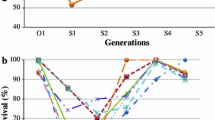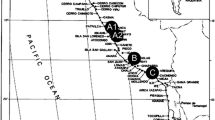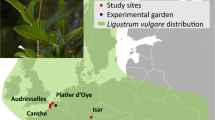Abstract
The extent of genetic divergence between the Mesoamerican and Andean gene pools and between evolutionary classes (wild, landrace and bred) in Phaseolus vulgaris was explored. The compatibility of crosses was assessed by the frequency with which pollination was successful and the number of seeds in the resulting pod. Mesoamerican genotypes were more effective as pollinators than Andean genotypes, regardless of the gene pool of the female parent. Though certain individual genotypes were more easily pollinated by genotypes of one or other of the gene pools, there was no consistent tendency for pollinations between genotypes within a gene pool to be more successful than those between gene pools. In crosses among wild and landrace genotypes, the landrace genotypes were more easily pollinated. In those among wild and bred genotypes, the bred genotypes were more effective as pollinators, and the number of seeds per pod was greater in crosses between the evolutionary classes than in those within classes. In crosses among landrace and bred genotypes, those within evolutionary classes had higher success rates than those between classes (47.2% vs. 38.9%), and produced more seeds per pod. However, these results do not represent a major barrier between the evolutionary classes. The hypothesis that dwarf-lethal incompatibility in inter-gene pool crosses is controlled by two complementary dominant genes (the DL-gene hypothesis) was tested by comparing the numbers of normal and abnormal plants in the progeny of three-way crosses, and the ratios obtained were consistent with the hypothesis. It is concluded that there is no biological barrier between the two gene pools and that they are distinct because, by accident of ancestry, they are located in geographically isolated and ecologically distinct areas, with different cultural practices and preferences. Research programmes aimed at transferring desirable traits between the gene pools should therefore be encouraged.
Similar content being viewed by others
References
Allard, R.W., 1960. Principles of Plant Breeding. Wiley, New York, U.S.A.
de Wet, J.M.J. & J.R. Harlan, 1975. Weeds and domesticates: Evolution in the manmade habitat. Econ. Bot. 29: 99–107.
Debouck, D.G. & Smartt, J., 1995. Beans. In: J. Smartt & N.W. Simmonds (Eds), Evolution of crop plants. Second edition, pp. 287– 294, Longman, Harlow, England.
Elliot, F.C., 1958. Plant Breeding and Cytogenetics. McGraw Hill, New York.
Genstat 5 Committee (1993) Genstat 5 Release 3 Reference Manual. Clarendon Press, Oxford, England.
Gepts, P., 1988. A Middle American and an Andean common bean gene pool. In: P. Gepts (Ed.), Genetic resources of Phaseolus beans, pp. 375–390, Kluwer, Dordrecht, Netherlands.
Gepts, P. & F.A. Bliss, 1985. F1 hybrid weakness in the common bean: differential geographic origin suggests two gene pools in cultivated bean germplasm. J. Hered. 76: 447–450.
Gepts, P. & F.A. Bliss, 1986. Phaseolin variability among wild and cultivated bean (Phaseolus vulgaris) from Colombia. Econ. Bot. 40: 469–481.
Gepts, P., Kmiecik, K., Pereira, P., & Bliss, F.A., 1988. Dissemination pathways of common bean (Phaseolus vulgaris, Fabaceae) deduced from phaseolin electrophoretic variability. 1. The Americas. Econ. Bot. 42: 73–85
Gepts, P., Nodari, R., Tsai, S.M., Koinange, E.M.K., Llaca, V., Gilbertson, R. & Guzmán, P., 1993. Linkage mapping in common bean. Annual Report of the Bean Improvement Cooperative 36: xxiv–xxxviii.
Gepts, P., T.C. Osborn, K. Rashka & F.A. Bliss, 1986. Phaseolin protein variability in wild forms and landraces of the common bean (Phaseolus vulgaris L.): evidence for multiple centres of domestication. Econ. Bot. 40: 451–468.
Harlan, J.R., 1975. Crops andMan. American Society of Agronomy, Madison, U.S.A.
Keller, W., 1952. Emasculation and Pollination Technics. International Grassland Congress Proceeedings 6: 1613–1619.
Koinange, E.M.K. & Gepts, P., 1992. Hybrid weakness in wild Phaseolus vulgaris L. J. Hered. 83: 135–139.
Ma, Y. & F.A. Bliss, 1978. Seed proteins of the common bean. Crop Sci. 18: 431–437.
Mukoko, O.Z., N.W. Galwey & D.J. Allen, 1995. Developing cultivars of the common bean (Phaseolus vulgaris L.) for southern Africa: bean common mosaic virus, consumer preferences and agronomic requirements. Field Crops Res. 40: 165–177.
Shii, C.T., M.C. Mok & D.W.S. Mok, 1981. Developmental controls of morphological mutants of Phaseolus vulgaris L. Differential expression of mutant loci in plant organs. Developmental Genetics 2: 279–290.
Singh, S.P. 1989. Patterns of variation in cultivated common bean (Phaseolus vulgaris, Fabaceae). Econ. Bot. 43: 39–57.
Singh, S P., 1995. Selection for seed yield in Middle American versus Andean × Middle American interracial common-bean populations. Plant Breeding 114: 269–271.
Singh, S.P. & J.A. Gutiérrez, 1984. Geographical distribution of the DL1 and DL2 genes causing hybrid dwarfism in Phaseolus vulgaris L., their association with seed size, and their significance to breeding. Euphytica 33: 337–345.
Smartt, J., 1990. Grain legumes. Evolution and genetic resources, Cambridge University Press, Cambridge, England. 379 pp.
White, J.W., C. Montez & L.Y. Mendoza, 1992. Use of grafting to characterise and alleviate hybrid dwarfness in common bean. Euphytica 59: 19–25.
Author information
Authors and Affiliations
Rights and permissions
About this article
Cite this article
Mumba, L., Galwey, N. Compatibility of crosses between gene pools and evolutionary classes in the common bean (Phaseolus vulgaris L.). Genetic Resources and Crop Evolution 45, 69–80 (1998). https://doi.org/10.1023/A:1008617527136
Issue Date:
DOI: https://doi.org/10.1023/A:1008617527136




